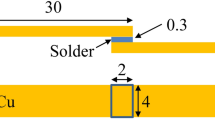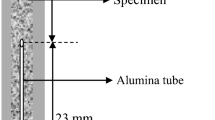Abstract
This work aimed to investigate the effects of some Bi additions (x = 0, 1, 3, and 5 wt%) added to Sn–2Cu solder alloy on its thermal properties, mechanical performance, and resistance to corrosion, which was investigated by using the Differential scanning calorimetry, Scanning electron microscope, Vickers Hardness Tester, Universal testing machine, Electrochemical workstation, and X-ray diffraction. The experimental results showed that doping 5 wt% Bi could reduce the melting point from 239.7 to 226.6 °C and the undercooling from 24.0 to 9.0 °C, which could improve the thermal properties. Moreover, the Bi addition could refine the microstructure and decrease the Cu6Sn5 IMC phases’ size. With the addition of 5 wt% Bi, the microhardness and tensile strength reached the highest value of 20.13 HV and 57.64 MPa, respectively, due to the solid solution strengthening and precipitation strengthening. The electrochemical corrosion behaviors were performed to use the potentiodynamic polarization and electrochemical impedance spectroscopy. The obtained results revealed that a dense passivation film was formed on the surface of Sn–2Cu–1Bi alloy to prevent the alloy from being further corroded, which had the lowest value of corrosion current density (0.034 μA·cm−2) and biggest value of total resistance (200.4 kΩ·cm2). Therefore, the Sn–2Cu–1Bi alloy had best corrosion resistance.















Similar content being viewed by others
Data availability
The data analyzed or generated in this study are available within this article.
References
S. Cheng, C.M. Huang, M. Pecht, A review of lead-free solders for electronics applications. Microelectron. Reliab. 75, 77–95 (2017). https://doi.org/10.1016/j.microrel.2017.06.016
M.A.A. Mohd-Salleh, A.M.M. Al-Bakri, M.H. Zan-Hazizi, F. Somidin, N.F.M. Alui, Z.A. Ahmad, Mechanical properties of Sn-0.7Cu/Si3Ni4 lead-free composite solder. Mater. Sci. Eng. A 556, 633–637 (2012). https://doi.org/10.1016/j.msea.2012.07.039
X. Bi, X. Hu, Q. Li, Effect of Co addition into Ni film on shear strength of solder/Ni/Cu system: experimental and theoretical investigations. Mater. Sci. Eng. A 788, 139589 (2020). https://doi.org/10.1016/j.msea.2020.139589
X. Hu, H. Xu, W. Chen, X. Jiang, Effects of ultrasonic treatment on mechanical properties and microstructure evolution of the Cu/SAC305 solder joints. J. Manuf. Process. 64, 648–654 (2021). https://doi.org/10.1016/j.jmapro.2021.01.045
S.A. Belyakov, J.W. Xian, K. Sweatman, T. Nishimura, T. Akaiwa, C.M. Gourlay, Influence of bismuth on the solidification of Sn-0.7Cu-0.05Ni-xBi/Cu joints. J. Alloys Compds. 701, 321–334 (2017). https://doi.org/10.1016/j.jallcom.2016.12.404
Y. Qiao, H. Ma, F. Yu, N. Zhao, Quasi-in-situ observation on diffusion anisotropy dominated asymmetrical growth of Cu-Sn IMCs under temperature gradient. Acta Mater. 217, 117168 (2021). https://doi.org/10.1016/j.actamat.2021.117168
X. Chen, M. Li, X.X. Ren, A.M. Hu, D.L. Mao, Effect of small additions of alloying elements on the properties of Sn-Zn eutectic alloy. J. Electron. Mater. 35, 1734–1739 (2006). https://doi.org/10.1007/s11664-006-0227-5
R.M. Shalaby, M. Kamal, E.A.M. Ali, M.S. Gumaan, Microstructural and mechanical characterization of melt spun process Sn-3.5Ag and Sn-3.5Ag-xCu lead-free solders for low cost electronic assembly. Mater. Sci. Eng. A 690, 446–452 (2017). https://doi.org/10.1016/j.msea.2017.03.022
M.S. Gumaan, R.M. Shalaby, M.K. Mohammed Yousef, E.A.M. Ali, E.E. Abdel-Hady, Nickel effects on the structural and some physical properties of the eutectic Sn-Ag lead-free solder alloy. Solder. Surf. Mt. Technol. 31, 40–51 (2019). https://doi.org/10.1108/SSMT-03-2018-0009
M.S. Gumaan, R.M. Shalaby, E.A.M. Ali, M. Kamal, Copper effects in mechanical, thermal and electrical properties of rapidly solidified eutectic Sn–Ag alloy. J. Mater. Sci.: Mater. Electron. 29, 8886–8894 (2018). https://doi.org/10.1007/s10854-018-8906-6
S.R. Abbas, M.S. Gumaan, R.M. Shalaby, Chromium effects on the microstructural, mechanical and thermal properties of a rapidly solidified eutectic Sn-Ag alloy. Solder. Surf. Mt. Technol. 32, 137–145 (2020). https://doi.org/10.1108/SSMT-04-2019-0017
P.L. Liu, J.K. Shang, Interfacial embrittlement by bismuth segregation in copper/tin–bismuth Pb-free solder interconnect. J. Mater. Res. 16, 1651–1659 (2001). https://doi.org/10.1016/S1359-6462(01)00670-4
K. Suganuma, Advances in lead-free electronics soldering. Curr. Opin. Solid State Mater. Sci. 5, 55–64 (2011). https://doi.org/10.1016/S1359-0286(00)00036-X
H. Wang, X. Hu, X. Jiang, Effects of Ni modified MWCNTs on the microstructural evolution and shear strength of Sn-3.0Ag-0.5Cu composite solder joints. Mater. Charact. 163, 110287 (2020). https://doi.org/10.1016/j.matchar.2020.110287
R. Rashidi, H. Naffakh-Moosavy, Metallurgical physical, mechanical and oxidation behavior of lead-free chromium dissolved Sn-Cu-Bi solders. J. Mater. Res. Technol. 13, 1805–1825 (2021). https://doi.org/10.1016/j.jmrt.2021.05.055
S. Chantaramanee, P. Sungkhaphaitoon, Influence of bismuth on microstructure, thermal properties, mechanical performance, and interfacial behavior of SAC305-xBi/Cu solder joints. Trans. Nonferrous Met. Soc. China 31, 1397–1410 (2021). https://doi.org/10.1016/S1003-6326(21)65585-1
G. Zeng, S. Xue, L. Zhang, L. Gao, Recent advances on Sn-Cu solders with alloying elements: review. J. Mater. Sci.: Mater. Electron. 22, 565–578 (2011). https://doi.org/10.1007/s10854-011-0291-3
G. Li, Y. Shi, H. Hao, Z. Xia, Y. Lei, F. Guo, Effect of phosphorus element on the comprehensive properties of Sn-Cu lead free solder. J. Alloys Compd. 491, 382–385 (2010). https://doi.org/10.1016/j.jallcom.2009.10.190
E. Çadırlı, U. Böyük, S. Engin, H. Kaya, N. Maraslı, A. Ülgen, Experimental investigation of the effect of solidification processing parameters on the rod spacings in the Sn-1.2 wt.% Cu alloy. J. Alloys Compds. 486, 199–206 (2009). https://doi.org/10.1016/j.jallcom.2009.07.027
Y.F. Gao, C.Q. Cheng, J. Zhao, L.H. Wang, X.G. Li, Electrochemical corrosion of Sn-0.75Cu solder joints in NaCl solution. Trans. Nonferrous Met. Soc. China 22, 977–982 (2012). https://doi.org/10.1016/S1003-6326(11)61273-9
D. Li, P.P. Conway, C. Liu, Corrosion characterization of tin–lead and lead free solders in 3.5 wt.% NaCl solution. Corros. Sci. 50, 995–1004 (2008). https://doi.org/10.1016/j.corsci.2007.11.025
W.R. Osório, E.S. Freitas, J.E. Spinelli, A. Garcia, Electrochemical behavior of a lead-free Sn–Cu solder alloy in NaCl solution. Corros. Sci. 80, 71–81 (2014). https://doi.org/10.1016/j.corsci.2013.11.010
G. Liu, S. Khorsand, S. Ji, Electrochemical corrosion behaviour of Sn-Zn-xBi alloys used for miniature detonating cords. J. Mater. Sci. Technol. 35, 1618–1628 (2019). https://doi.org/10.1016/j.jmst.2019.03.026
J. Cheng, X. Hu, Q. Li, X. Jiang, Influences of Ni addition into Cu-xNi alloy on the microstructure evolution and mechanical property of Sn-58Bi/Cu-xNi solder joint. Appl. Phys. A (2020). https://doi.org/10.1007/s00339-020-03483-9
R. Sayyadi, H. Naffakh-Moosavy, Physical and mechanical properties of synthesized low Ag/lead-free Sn-Ag-Cu-xBi (x=0, 1, 2.5, 5 wt%) solders. Mater. Sci. Eng.: A 735, 367–377 (2018). https://doi.org/10.1016/j.msea.2018.08.071
R. Sayyadi, H. Naffakh-Moosavy, The role of intermetallic compounds in controlling the microstructural, physical and mechanical properties of Cu-[Sn-Ag-Cu-Bi]-Cu solder joints. Sci. Rep. 9, 1–20 (2019). https://doi.org/10.1038/s41598-019-44758-3
A.A. El-Daly, W.M. Desoky, A.F. Saad, N.A. Mansor, E.H. Lotfy, H.M. Abd-Elmoniem, H. Hashem, The effect of undercooling on the microstructure and tensile properties of hypoeutectic Sn-6.5Zn-xCu Pb-free solders. Mater. Des. 80, 152–162 (2015). https://doi.org/10.1016/j.matdes.2015.05.016
X. Hu, Y. Li, Y. Liu, Z. Min, Developments of high strength Bi-containing Sn0.7Cu lead-free solder alloys prepared by directional solidification. J. Alloys Compds. 625, 241–250 (2015). https://doi.org/10.1016/j.jallcom.2014.10.205
A.A. El-Daly, A.M. El-Taher, S. Gouda, Novel Bi-containing Sn-1.5Ag-0.7Cu lead-free solder alloy with further enhanced thermal property and strength for mobile products. Mater. Des. 65, 796–805 (2015). https://doi.org/10.1016/j.matdes.2014.10.006
J. Zhao, L. Qi, X. Wang, L. Wang, Influence of Bi on microstructure evolution and mechanical properties in Sn-Ag-Cu lead-free solder. J. Alloys Compds. 375, 196–201 (2004). https://doi.org/10.1016/j.jallcom.2003.12.005
M.H. Mahdavifard, M.F.M. Sabri, D.A. Shnawah, S.M. Said, I.A. Badruddin, S. Rozali, The effect of iron and bismuth addition on the microstructural, mechanical, and thermal properties of Sn-1Ag-0.5Cu solder alloy. Microelectron. Reliab. 55, 1886–1890 (2015). https://doi.org/10.1016/j.microrel.2015.06.134
L. Yang, F. Sun, X. Li, Effect of Ni, Bi concentration on the microstructure and shear behavior of low-Ag SAC-Bi-Ni/Cu solder joints. J. Mater. Sci.: Mater. Electron. 25, 2627–2633 (2014). https://doi.org/10.1007/s10854-014-1921-3
J. Shen, Y. Pu, D. Wu, Q. Tang, M. Zhao, Effects of minor Bi, Ni on the wetting properties, microstructures, and shear properties of Sn-0.7Cu lead-free solder joints. J. Mater. Sci.: Mater. Electron. 26, 1572–1580 (2015). https://doi.org/10.1007/s10854-014-2577-8
J. Koo, J. Chang, Y.W. Lee, H.J. Hong, K.S. Kim, H.M. Lee, New Sn-0.7Cu-based solder alloys with minor alloying additions of Pd, Cr and Ca. J. Alloys Compds. 608, 126–132 (2014). https://doi.org/10.1016/j.jallcom.2014.03.194
B. Ali, M.F.M. Sabri, S.M. Said, N.L. Sukiman, I. Jauhari, M.H. Mahdavifard, Microstructure and tensile properties of Fe and Bi added Sn-1Ag-05Cu solder alloy under high temperature environment. Microelectron. Reliab. 82, 171–178 (2018). https://doi.org/10.1016/j.microrel.2018.01.015
M.I.I. Ramli, M.A.A. Mohd Salleh, H. Yasuda, J. Chaiprapa, K. Nogita, The effect of Bi on the microstructure, electrical, wettability and mechanical properties of Sn-0.7Cu-0.05Ni alloys for high strength soldering. Mater. Des. 186, 108281 (2020). https://doi.org/10.1016/j.matdes.2019.108281
U.S. Mohanty, K.-L. Lin, Potentiodynamic polarization measurement of Sn-8.5Zn-xAl-0.5Ga alloy in 3.5% NaCl solution. J. Electrochem. Soc. 153, B319–B324 (2006). https://doi.org/10.1149/1.2209569
H. Oulfajrite, A. Sabbar, M. Boulghallat, A. Jouaiti, R. Lbibb, A. Zrineh, Electrochemical behavior of a new solder material (Sn-In-Ag). Mater. Lett. 57, 4368–4371 (2003). https://doi.org/10.1016/S0167-577X(03)00326-4
L.C. Tsao, Corrosion resistance of Pb-free and novel nano-composite solders in electronic packaging. Corros. Resist. 107, 132 (2012). https://doi.org/10.5772/33228
L.C. Tsao, in 2009 International Conference on Electronic Packaging Technology & High Density Packaging (ICEPT-HDP), (2009), pp. 1164–1166
D.Q. Yu, C.M.L. Wu, L. Wang, in 16th International Corrosion Congress (Beijing, P.R. China, 2005), pp. 19–24
D. Li, P.P. Conway, C. Liu, Corrosion characterization of tin–lead and lead free solders in 3.5wt.% NaCl solution. Corros. Sci. 50, 995–1004 (2008). https://doi.org/10.1016/j.corsci.2007.11.025
R. Mishra, R. Balasubramaniam, Effect of nanocrystalline grain size on the electrochemical and corrosion behavior of nickel. Corros. Sci. 46, 3019–3029 (2004). https://doi.org/10.1016/j.corsci.2004.04.007
E. McCafferty, Validation of corrosion rates measured by the Tafel extrapolation method. Corros. Sci. 47, 3202–3215 (2005). https://doi.org/10.1016/j.corsci.2005.05.046
X. Bi, Z. Luo, B. Liu, M. Xu, Z. Wang, Enhancing interfacial reliability of metal-thermoplastic hybrid joints via adding carbon fiber and adjusting welding heat input. ACS Appl. Mater. Interfaces 13, 33722–33733 (2021). https://doi.org/10.1021/acsami.1c08977
H.W. Pickering, Characteristic features of alloy polarization curves. Corros. Sci. 23, 1107–1120 (1983). https://doi.org/10.1016/0010-938X(83)90092-6
S. Hong, W. Chen, Y. Zhang, H.Q. Luo, M. Li, N.B. Li, Investigation of the inhibition effect of trithiocyanuric acid on corrosion of copper in 3.0 wt.% NaCl. Corros. Sci. 66, 308–314 (2013). https://doi.org/10.1016/j.corsci.2012.09.034
W.R. Osório, J.E. Spinelli, C.R.M. Afonso, L.C. Peixoto, A. Garcia, Microstructure, corrosion behaviour and microhardness of a directionally solidified Sn–Cu solder alloy. Electrochim. Acta 56, 8891–8899 (2011). https://doi.org/10.1016/j.electacta.2011.07.114
H.A. Acciari, A.C. Guastaldi, C.M.A. Brett, Corrosion of the component phases presents in high copper dental amalgams. Application of electrochemical impedance spectroscopy and electrochemical noise analysis. Corros. Sci. 47, 635–647 (2005). https://doi.org/10.1016/j.corsci.2004.07.004
M.C. Liew, L. Ahmad, M.L. Liu, M.F.M. Nazeri, H. Haliman, A.A. Mohamad, Corrosion behavior of Sn-3.0Ag-0.5Cu lead-free solder in potassium hydroxide electrolyte. Metall. Mater. Trans. A 43, 3742–3747 (2012). https://doi.org/10.1007/s11661-012-1194-5
D. Xia, S. Song, R. Zhu, Y. Behnamian, C. Shen, J. Wang, J. Luo, Y. Lu, S. Klimas, A mechanistic study on thiosulfate-enhanced passivity degradation of Alloy 800 in chloride solutions. Electrochim. Acta 111, 510–525 (2013). https://doi.org/10.1016/j.electacta.2013.08.030
D.-Q. Yu, C.M.L. Wu, L. Wang, The electrochemical corrosion behavior of Sn-9Zn and Sn-8Zn-3Bi lead-free solder alloys in NaCl solution. In 16th International Corrosion Congress. (Beijing, China, 2005), pp. 19–24
E.J. Sutow, D.W. Jones, G.C. Hall, C.G. Owen, Crevice corrosion products of dental amalgam. J. Dent. Res. 70, 1082–1087 (1991). https://doi.org/10.1177/00220345910700071301
Acknowledgements
This work was supported by the National Natural Science Foundation of China (No. 52165047).
Author information
Authors and Affiliations
Contributions
HH: Studying conception and design, Sample preparation, Experiments, Data curation and analysis, Writing—original draft. BC: Data curation, Investigation, Visualization. XH: Methodology, Writing—review & editing. XJ and QL: Resources, Supervision, Investigation, Validation. YC and SZ: Investigation, Formal analysis. DL: Resources, Investigation, Methodology.
Corresponding author
Ethics declarations
Conflict of interest
The authors declare that they have no conflict of interest in this paper.
Additional information
Publisher's Note
Springer Nature remains neutral with regard to jurisdictional claims in published maps and institutional affiliations.
Rights and permissions
About this article
Cite this article
Huang, H., Chen, B., Hu, X. et al. Research on Bi contents addition into Sn–Cu-based lead-free solder alloy. J Mater Sci: Mater Electron 33, 15586–15603 (2022). https://doi.org/10.1007/s10854-022-08464-7
Received:
Accepted:
Published:
Issue Date:
DOI: https://doi.org/10.1007/s10854-022-08464-7




